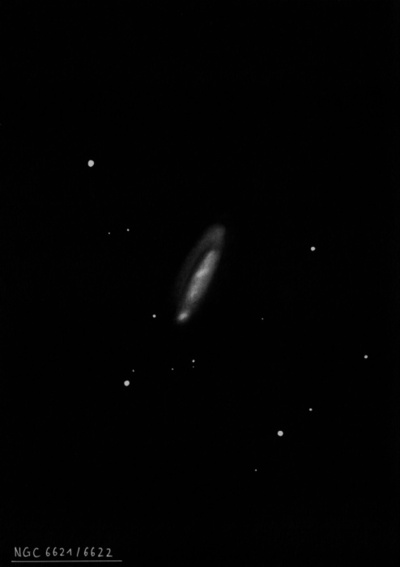
Edward Swift, the 14 year-old son of Lewis, discovered NGC 6621 = Sw. I-95 on 2 Jun 1885. The Swifts' position was 19 sec of RA too far east. This galaxy is the brighter of a very close double system, just 40" between centers. Apparently Lewis took another look in the eyepiece and discovered NGC 6622 = Sw. I-96. The note "n of 2" and "s of 2" were probably added after noticing it was double. Lewis Swift "discovered" this close pair again just two months later on 11 Aug 1885 and placed them in his second list (II-65 and II-66). He noted "forms a close double with the preceding. Very difficult to separate with power of 265. Well seen."
Dreyer combined the two observations in the NGC, though the published position is 14 seconds of time too large and 2' too far south. In addition, the RA is identical, though the orientation is northwest-southeast, and NGC 6622 is placed 0.2' north of NGC 6621. Bigourdan measured an accurate position for the pair on 28 Aug 1891 as well as Hermann Kobold in May 1899. When Herbert Howe measured the positions in 1899-00, he assigned NGC 6622 to the northwest galaxy and NGC 6621 to the southeast (agreeing with Swift's dec values), but modern catalogues reverse the identifications, placing the numbers in order of RA.
400/500mm - 17.5" (6/11/88): fairly faint, small, irregularly round, small bright core, stellar nucleus. Forms a double galaxy in a common envelope with NGC 6622 just 40" SE of center. A mag 15 star is 30" E.
900/1200mm - 48" (5/5/16): at 610x and 697x; NGC 6621/6622 is a spectacular interacting system (Arp 81 = VV 247) with an amazing tidal tail that wraps around both galaxies. NGC 6621 is sharply concentrated with a very bright, roundish core that increases to the center. The main halo or arms is elongated ~3:1 NW-SE, ~60"x20" with slightly brighter "handles" (ends of the spiral arms) on the NW and SE end. The enhancement on the NW side is more evident.
The southeast end merges with the halo of NGC 6622 with the cores of the galaxies separated by 40". A very small knot (at most 10" in size) was visible on a line between the two cores [16" NW of NGC 6622 and 26" SE of NGC 6621]. The HST image reveals this is a prominent blue starburst complex at the edge of the two galaxies.
On the northwest end, a broad tidal arm wraps sharply counterclockwise to the southeast (the arm is easily visible in this part), dims into a narrow tail and extends southeast, paralleling (about 30" to the east) the major axis of NGC 6621. This one-sided tail extends ~1.5' in length in the direction of a mag 15 star due east of NGC 6622 and ends in a slightly brighter knot, ~25" NE of NGC 6622.
48" (10/22/11): at 488x the main body of NGC 6621, which completely merges with NGC 6622, appears bright, fairly large, elongated nearly 3:1 NNW-SSE, ~1.1'x0.4'. Including NGC 6622 at the southeast end, the entire glow extends ~1.6'x0.4'. NGC 6621 is fairly sharply concentrated with a bright 20" core that gradually increases to the center. At 610x, a faint spiral arm is fairly evident attached at the NNW end and winding around counterclockwise to the north side of the main glow. On the HST image this is the beginning of a long tidal tail that wraps around the north side of both galaxies.
Notes by Steve Gottlieb